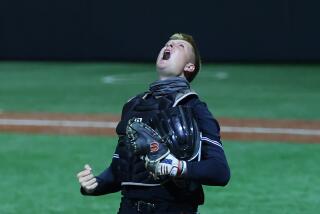California League: Feeding the Major Leagues Since 1941
- Share via
As the JetHawks prepare to bring professional baseball to the Antelope Valley, some observers have been reminded of the Golden State Baseball League, which folded last summer after barely a week of play.
But the Golden State League, which was not affiliated with major league baseball, and the California League, which has been stocking the majors with players since 1941, simply do not compare.
The Cal League has produced such Hall of Fame players as Don Drysdale and Reggie Jackson, and such current stars as Ken Griffey Jr. and Mike Piazza.
Bill Weiss, statistician for the league, estimates that roughly a quarter of the players in the major leagues have come through the Cal League.
The Cal League is considered advanced Class A, along with the Carolina and Florida State leagues. All three circuits are a step above the South Atlantic and Midwest leagues, which are a step above the short-season Class-A leagues: the New York-Penn and the Northwest leagues.
Even lower are rookie leagues, which include mostly players in their first summer of professional baseball.
Most major league teams have affiliates at each of the three levels of Class-A baseball and one rookie team.
Although the Cal League is far from the bottom of the player development totem pole, it’s still far enough from the top that only two or three players per team can expect to reach the majors.
Most players in the league are between the ages of 21 and 25 and have been in pro baseball for two to four seasons.
From a playing or coaching standpoint, it is considered one of the better leagues in which to be assigned because of facilities, travel and weather.
“I love the league,” JetHawk Manager Dave Brundage said. “And I’ve played in damn near every league there is. This is one of the best leagues because of the stadiums, the fan support, the talent, the weather, the travel.”
Once San Bernardino’s new ballpark is completed this summer, the 10-team Cal League will boast five state-of-the-art stadiums opened within the past five years. All five are in the Southern Division--Lancaster, High Desert, Lake Elsinore, Rancho Cucamonga and San Bernardino.
Largely because of the quality of their stadiums, High Desert, Rancho Cucamonga and Lake Elsinore annually have set franchise attendance records. Last season, Rancho Cucamonga led the league in attendance with 446,146, third among all Class-A teams.
The league is also a favorite because of the teams’ proximity to one another. The JetHawks, for example, will play 116 of their 140 games within a two-hour drive of Lancaster. On the shortest trips, the team will return home after games.
Despite the heat of the desert communities, most players consider themselves lucky to be spared the humidity and rain of the Carolina and Florida State leagues.
“It’s probably the best league I’ve played in,” said JetHawk pitcher Ivan Montane, who played last season in Riverside. “You couldn’t ask for anything more.”
Notes
The season is divided into 70-game halves, with the second half starting June 19. Six of the 10 teams make the playoffs: the North and South division winners from each half, plus the team with the next-best overall record in each division.
The teams with the best overall records in each division get first-round byes, while the other two play a best-of-three series. The winners of those series then play each division’s top team in a best-of-five series.
Those winners advance to a best-of-five series for the league title. The San Bernardino Spirit, a Dodger affiliate now known as the Stampede, defeated the San Jose Giants in three games for the championship last season.
The league’s All-Star game, which will be played June 18 at Rancho Cucamonga, has a new format. A team of Cal League All-Stars will play a team of Carolina League All-Stars.
(BEGIN TEXT OF INFOBOX / INFOGRAPHIC)
Notable Alumni
Below, major league players with their current affiliations, and the California League cities they played in.
Eric Karros: DODGERS / BAKERSFIELD
Raul Mondesi: DODGERS / BAKERSFIELD
Mike Piazza: DODGERS / BAKERSFIELD
Ken Griffey Jr.: MARINERS / SAN BERNARDINO
Mark Langston: ANGELS / BAKERSFIELD
Tim Salmon: ANGELS / PALM SPRINGS
Players to Watch
Following is a list of players of local or national interest or those considered top prospects--as judged by Baseball America--who will play against the JetHawks this season.
They are taken from opening day rosters. Players are grouped by team, with affiliation in parentheses, and the dates of the teams first trip to Lancaster.
Bakersfield Blaze (Co-op), May 27-29
Chris Paxton, C, Palmdale High.
High Desert Mavericks (Baltimore Orioles), April 19-21
David Lamb, SS, Newbury Park High.
Lake Elsinore Storm (Angels), May 7-9
Ty Van Burkleo, IF, Chatsworth High.
Jarrod Washburn, LHP, Angels’ No. 3 prospect.
Modesto A’s (Oakland Athletics)
Ben Grieve, OF, A’s top prospect.
Steve Karsay, RHP, Major League starter on injury rehabilitation.
Dave Newhan, OF, Pepperdine.
Miguel Tejada, SS, A’s No. 5 prospect.
San Bernardino Stampede (Dodgers), April 29-May 2
J.P. Roberge, 1B, St. Francis High, USC.
Rancho Cucamonga Quakes (San Diego Padres), April 26-28
Ben Davis, C, No. 2 pick in 1995 draft, top catching prospect in baseball.
Gary Matthews, OF, Mission College, Granada Hills High.
San Jose Giants (San Francisco Giants), May 21-23
Bobby Bonds Jr., OF, Younger brother of Barry Bonds.
Joe Fontenot, RHP, Giants’ No. 2 prospect.
Russ Ortiz, RHP, Montclair Prep, Giants’ No. 10 prospect.
Stockton Ports (Milwaukee Brewers), May 10-12
Dan Klassen, SS, Brewers’ No. 6 prospect.
Visalia Oaks (Co-op)
Del Marine, C, Moorpark College, Canoga Park High.
Vladimir Nunez, RHP, Cuba, $1.75 million signing bonus from Diamondbacks.
Larry Rodriguez, RHP, Cuba, $1.25 million signing bonus from Diamondbacks.
More to Read
Go beyond the scoreboard
Get the latest on L.A.'s teams in the daily Sports Report newsletter.
You may occasionally receive promotional content from the Los Angeles Times.










